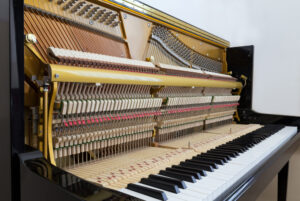As private music teachers working with beginner students every day, we’ve found that students who understand how their instrument works tend to play with more confidence and control. That’s why we believe learning the parts of a piano is a foundational step in piano education.
Whether you’re taking your first lesson or supporting a child who’s just started learning, this breakdown of piano anatomy will help demystify the instrument and set the stage for better playing habits.
The Exterior: What You See and Touch
Let’s start with the parts you interact with during every lesson.
1. Keys
The most familiar part—modern pianos have 88 keys (52 white, 36 black). Each key controls a hammer that strikes a string.
2. Pedals
- Sustain Pedal (Right): Makes the notes ring out longer
- Soft Pedal (Left): Softens the tone
- Sostenuto Pedal (Middle): Sustains selected notes (not always present on digital pianos)
3. Music Stand
Also called the music rack, this holds your books or sheet music upright during practice.
4. Fallboard
This is the wooden cover that protects the keys when the piano is not in use. Always close it gently!
The Interior: What Happens When You Play
Understanding the parts of a piano inside the case can help you appreciate the mechanics behind your music.
5. Strings
Every key is connected to one, two, or three strings. When struck, they vibrate to create sound.
6. Hammers
These felt-covered mallets strike the strings when you press a key.
7. Soundboard
The wooden plate beneath the strings that amplifies sound—essentially the speaker of the piano.
8. Action Mechanism
The collection of levers and parts that connect your keypress to the hammer’s movement. This is what gives pianos their signature “feel.”
Want to explore how long it takes to build muscle memory using these parts effectively? Check out our blog on how long it takes to learn piano.
Acoustic vs. Digital Pianos
While digital pianos don’t contain strings or hammers, they replicate the same key action using weighted keys and sensors. Learning the parts of a piano still applies—you’re using the same motor skills and techniques!
For more on how digital pianos compare, the Yamaha Music website offers a great side-by-side overview of piano types and parts.
FAQ
Why do piano keys feel heavier on some pianos?
It depends on the piano’s action mechanism and whether it’s acoustic or digital. Weighted keys mimic the resistance created by real hammers and strings.
What’s the difference between upright and grand pianos?
Both have the same core parts, but the string and hammer placement differ. Grand pianos have horizontal strings, while uprights are vertical.
Can understanding piano parts help my child play better?
Yes! Knowing how their actions affect the sound can help students play with better technique and care.
Final Thoughts
Learning the parts of a piano gives students a greater appreciation for their instrument and helps them play more mindfully. It’s not just about pushing keys—it’s about understanding the incredible machine behind the music.
